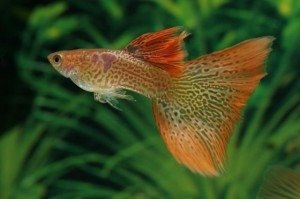
1. It is fair enough at the beginning to have trios of breeding healthy guppies from one or two species only. Provide about 8 to 10 tanks for preserving a purely single breed. As for fry and breeders, smaller 5 gal tank should be sufficient as container. Guppies are not challenging to keep since they easily adapt to varying water conditions.
Initial Step to Breeding Healthy Guppies
Moderate hardness of pH 7.2 is excellent environment for them, though they can survive water of between pH 6.4 and 8.6 providing they get orientated appropriately. Place new breeding healthy guppies in clean breeding container just enough for keeping trios, yet also large enough to accommodate equal water volume for new tank. Avoid floating the sealed bags and put trios in container once through and leave them off for a while.
Start by pouring approximately 3-4 ounces of water gradually into tank after 15 minutes. Execute this stepwise over an hour, until volume of water doubles up. Then, pour fish out into new container after getting accustomed. Give them small amounts of food afterwards. Wait until next day in order to feed the guppies again. Start breeding fry after about a month. Have an extra container for baby breeding guppies. About 3 to 4 weeks later, sort out virgin females from other fry for breeding healthy guppies in future.
2. Keeping the fry in tiny containers facilitates them to find food easily. After attaining about 60 fry, breed them in 10-gallon containers separately.
3. Feed new-born fry with salt water shrimp of young age daily up to 4 months old to support development.
4. Essentials of nearly all choice breeding guppies are contained in box filters. Just provide polyester cotton layer along with some marble gravel. Dolomite gravel widely available in most pet stores selling brine fish makes for excellent water buffer. Oyster is also good substitute for dolomite. Sponge filters are equally good if utilized well. Ensure sponge filters get thoroughly rinsed without destroying living bacteria.
5. Observe 30 to 50% weekly water changes for healthy breeding guppies. Tap tanks from bottom always and avoid pouring water previously lost through evaporation into tanks. Acquire water equipment that is quality assured. Hardness, ammonia and pH kits are user friendly. If breeding guppies for first time, get good understanding of raising tropical fish.
6. Keep guppies attractive by feeding them periodically since overfeeding is main death cause among tropical fish. Tiny pinches of squashed flake food are best food variety for this fish type, which should be dished out hourly at least. Guppies can get indigestion if fed on freeze dried food thus keep off from it. Do not feed fish especially when aggressive.
7. Separate fry by sexes at between 4 to 5 weeks afterward. Sort out adequate number of females for next set of breeding guppies. Distinguish females by dark spot located directly above anal fins where fertilization occurs, referred as “gravid spot”. Carry out culling to eliminate inferior breeders.
8. Maintain simple tank without plants which can cause crowding. Research various helpful books on life cycle of breeding guppies, like those on tropical fish fundamentals especially if you have not raised live-bearers previously. Female fish gets rounder and fatter in shape when pregnant and may appear squared-off immediately before giving birth. “Gravid spot” looks darker also.
9. Observe temperatures of about 76 to 82 degrees for fry and breeders while keeping it between 72 to 76 degrees for older guppies.
10. Avoid acquiring excessive number of fish at the start. Guppies reproduce every 30 to about 36 days. Do not mix different litters until 3 months old, which applies to guppies of same breed. Starting off with highest possible quality strain of breeding guppies is the most vital stage to observe though.